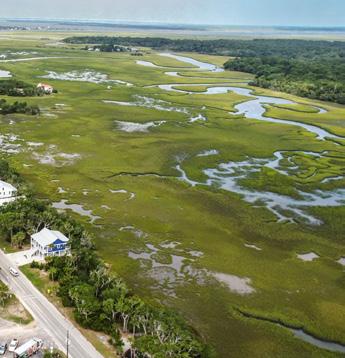CONNECTION
Hurricane safety
Make your plans now


Make your plans now


Irecently spent the morning at the White House celebrating the historic announcement of $42.5 billion allocated to all the states and territories in our union to help bridge the digital divide as part of the Broadband Equity, Access, and Deployment program, also known as BEAD.
The buzz in the security line was electric as folks lined up early to compare notes on why we are all passionate about broadband deployment, and I enjoyed sharing the activities of community-based broadband providers. I found myself beaming when a few people specifically referenced the fiber networks deployed by NTCA member companies. I love that the hard work of these companies and co-ops like yours is finally getting the credit that is due.
Mitch Landrieu, head of infrastructure initiatives for President Joe Biden, kicked us off and turned the podium to Commerce Secretary Gina Raimondo, who is leading BEAD and has genuinely put her passion behind her work. President Biden then took the podium and got right into sharing how much this historic investment in broadband means for our country. I was delighted to hear all the administration’s folks share a mindset on the importance of reliable, comparable and affordable broadband and even how fiber is really the technology of choice for this historic investment.
As Secretary Raimondo noted, it really was a “happy broadband day.” And, with the support of your community-based provider, we are sure to have many more delightful broadband days in the future.
Life is often lived online, including working, socializing, learning, relaxing and more. Without fast internet access, however, these day-to-day essentials grind to a halt. But for rural communities, the stakes are even higher.
While it’s something we might take for granted — at least for those of us who have access to broadband — the power of fast internet to profoundly improve quality of life remains striking.
ECONOMIC OPPORTUNITIES: High-speed internet helps rural businesses expand their reach through e-commerce — possibly even connecting globally.
REMOTE WORK: Rural workers can tap into a pool of work-from-home jobs, allowing residents to avoid commutes or the possibility of relocating for work.
HEALTH CARE: Telemedicine and access to medical resources — such as time-sensitive treatments like stroke care — are critical.
–4–
EDUCATION: Rural schools, colleges and students can tap vast resources, including virtual classrooms and distance learning programs.
AGRICULTURE: Online resources allow farmers in rural areas to optimize crop management, monitor livestock, access weather information and more.
That’s just the beginning. New opportunities will continue to appear, and rural internet providers will make the connections to bring those services to you.
Fall is prime time for sports fans. There’s both college and NFL football. The baseball regular season wraps up, followed by the playoffs and World Series. The first NBA games tip off, too. And with such a rich stew of possibilities, the buffet of options for viewing sports is tastier than ever.
Once, a sports fan might be limited to viewing the feats of only regional teams, and the selection of those games was limited to the lineup a TV network offered. Now, however, sports fans can choose streaming services that best suit their interests and budgets. Pricing can change at any time, though, so verify the cost when you’re ready to make a gametime decision.

g NFL Game Pass: For pro football fans, NFL Game Pass is a gamechanger. This streaming service provides access to live out-of-market games. It’s hard to beat if you’re a fan who wants to keep up with a favorite team whose games typically aren’t
broadcast in your TV market. NFL Game Pass also offers on-demand replays, condensed games and access to an extensive archive of previous seasons. While Game Pass is just one possibility for streaming NFL games, it’s a good one.
g NBA League Pass: Do you love professional basketball? Thanks to NBA League Pass, there’s a premium service perfect for anyone hooked on the NBA. There’s coverage of live games and the opportunity to watch past games on demand. There’s plenty of analysis, features, interviews and more. And it also works great on most devices.
g Paramount+, Amazon Prime Video and Apple TV: These services aren’t known primarily as platforms that feature sports. Instead, they established footholds by offering deep libraries of new TV shows and movies, as well as catalogs of longtime favorites. But if you’re already subscribing to stream from one of these services, or other
similar ones, take a closer look. You might be surprised by the sports available on a subscription you already have.
g YouTube TV: If you want an experience that’s close to traditional TV — all the big networks and smaller ones, too — check out YouTube TV. ABC, CBS, NBC, ESPN and more are all available, and they’re streaming in real time. You see the games as they’re happening. You can even record events so you can watch them later.
g ESPN+: Are you a fan of sports other than the big leagues? ESPN+ takes a deep dive into soccer, tennis and more. There’s coverage of everything from Ultimate Fighting Championship bouts to U.S. Open tennis. Smaller college conferences, such as the Ivy League and Conference USA, are showcased, with baseball, softball, hockey, wrestling and more. There’s even access to a library of content from the ESPN documentary series “30 for 30.”
to
Also, PRTC is not alone, and neither are you. We’re proud to be part of a nationwide co-op family, a supportive group of likeminded companies committed to uplifting areas in rural America that for-profit companies have often ignored.
PRTC Connection is a bimonthly newsletter published by PRTC, © 2023. It is distributed without charge to all member/owners of the cooperative.
JASON DANDRIDGE Chief Executive OfficerWhile many communities like ours are catching up, a gap remains between the resources available in rural America versus those found in larger cities. Every day, we work to bridge this digital divide by bringing you resources like internet service at speeds that often beat those found in metropolitan areas. And we do it affordably and reliably.
Each October, during National Cooperative Month, the co-op world honors these efforts that show how neighbors helping neighbors can benefit everyone. You see, as a member of the cooperative, you are very much a part of PRTC, right down to electing the board members who direct us. When people succeed by working together, isn’t it worth celebrating? We think so.
In the cooperative model, unlike with most for-profit corporations, our primary focus is on the needs of our members. Everyone at PRTC lives nearby, so we understand not only the successes our area achieves, but also the challenges we face.
Just like other companies that are part of the co-op community, we hold fast to a set of shared principles, promoting fairness, democracy and community development. Cooperative Month gives us a chance to amplify our voices and raise awareness about these efforts.
After all, we have seen firsthand the profound difference fast internet and other services can make. They opened the doors to economic development, more educational resources and a greater diversity of health care services thanks to telemedicine.
None of this, however, is possible without you. Our strength lies in your active participation and engagement with PRTC. Whether through attending meetings, volunteering or serving on the board, our members are crucial in shaping the direction of this cooperative.
Cooperative Month is significant for us, allowing time to reflect on where we’ve been and where we’re going. It’s an opportunity to celebrate our achievements, to raise awareness about the power of the cooperative world and to thank you for your help. Together, we’ll continue to make our community the best it can possibly be.
is a member-owned cooperative providing a complete telecommunications solution (internet, video, voice, wireless and security) to the homes and businesses in the Lowcountry of South Carolina.

Send address corrections to: PRTC
P.O. Drawer 1577
Walterboro, SC 29488

Telephone: 843-538-2022 prtc.us
For information about the content included in PRTC Connection, please contact Sean Gruber, Public Relations and Marketing Coordinator, at 843-538-9330.
BOARD OF DIRECTORS
District 1 - Brian Ackerman
District 2 - Cynthia “Cindy” Colson
District 3 - Lynn Tanner
District 4 - Michael Crosby
District 5 - Gloria Warren
District 6 - Travis Avant
District 7 - Heath Griffith
Produced for PRTC by:
On the Cover: Hurricane Gracie left her mark on Edisto Island in 1959, and it’s still the storm experts reference when talking about preparing for the worst. Learn more about how to stay safe during hurricanes. See story Page 8.
Our world changes quickly when it comes to technology and how we interact with one another. But ever since we built the first telephone lines, we’ve been devoted to providing the services you need to stay engaged, connected and secure. At times, it can prove challenging to bring cutting-edge technologies
a rural community like ours, but with your support we’re succeeding.
PRTC has been named as one of the Best Places to Work in South Carolina.

SC Biz News created this annual program in partnership with the South Carolina Chamber of Commerce and Best Companies Group. The survey and awards program, now in its 18th year, was designed to identify, recognize and honor the best employers in the state of South Carolina, benefiting the state’s economy, workforce and businesses.
Best Places to Work in South Carolina is a research-driven program from Best Companies Group that examines a company’s practices, programs and benefits and surveys employees for their perspectives. Companies that
meet certain benchmarks are considered Best Places to Work in South Carolina.
PRTC is ranked in the medium employer category, which consists of companies with between 50 and 249 employees.
“We at PRTC are committed to excellent customer service along with state-of-the-art technology, and it’s our amazing group of employees that helps make that possible,” CEO Jason Dandridge says. “We are honored to be named as one of the Best Places to Work in South Carolina again this year.”

Construction is in progress on County Line, Hyde Park, Parkers Ferry, Mauss Hill, Penny Creek and Weeks roads.
Construction is complete for County Line Road and Gettysville.
Construction continues in Farrells, Edisto River, Old Buckhead and Gaskins roads and
Happy Labor Day!
surrounding areas, as well as in the town of Olar and Colston, Carver, Sand Drag, Macedonia Church and Rivers Bridge roads and surrounding areas.
Red Dam construction is complete and installations are in progress.
Other projects expected to be complete in the coming months include Cummings, Varnville, Brunson, Tillman and Robertville.
Two area teenagers represented PRTC in June at the Foundation for Rural Service Youth Tour in Washington, D.C. Sidney Bailey, a senior at Colleton Preparatory Academy, and Lucas Chavis, a senior at Dorchester Academy, both made their first trips to the nation’s capital for the weeklong event.
The students toured several national monuments, the Capitol building and governmental offices, including the Federal Communications Commission. Lucas and Sidney met students from all over the country, representing 34 of 50 states.
“It was a fun and informative trip,” Sidney says. “It makes me want to explore more and have more traveling experience.”
Both students say visiting the FCC was one of the most informative parts of the tour. “I really enjoyed the tour at the FCC. I learned a lot about the role the FCC plays in communication and found that very interesting,” Lucas says.
Lucas is the son of Kimberly and Kevin Hartzog, of Grover. Sidney is the daughter of Rhonda and Brent Bailey, of Walterboro.


Since 1995, FRS has hosted the Youth Tour for thousands of high school students from across rural America. The tour is a chance for students to visit the nation’s capital and learn about rural broadband, share their community’s story with key legislative, regulatory and government figures, as well as a forum for them to meet and interact with their peers from other rural communities.
FRS was established in 1994 as a nonprofit by the NTCA–The Rural Broadband Association and plays a unique role within the telecommunications industry by supporting rural telecom companies, consumers and policymakers with educational information, products and programming.
 Story by ANNE BRALY
Story by ANNE BRALY
Lights, camera, action! Those words, once heard primarily in Hollywood studios, now echo through wooded forests and city streets across the South. And for many, a visit to places they’ve seen on the silver screen adds some excitement to a vacation.
“Film has always been such a powerful medium, and I think people enjoy being a part of something that meant so much to them,” says Dan Rogers, senior project manager for the South Carolina Film Commission.

It’s widely known that the Atlanta area is a hot spot for zombies in “The Walking Dead” and the unusual happenings in “Stranger Things.” Nashville’s been given the nod by directors, too, with films including “The Green Mile,” with Tom Hanks, and “Coal Miner’s Daughter,” starring Sissy Spacek as Loretta Lynn, filming in Music City.
Small towns, too, have seen their share of screen time. Black Mountain and Cedar Mountain, both in western North Carolina, were locations for several scenes in “The Hunger Games.” Berry College in Rome, Georgia, was transformed into Carmichael Plantation in scenes from “Sweet Home Alabama.” Also, Tidalholm Mansion along the Beaufort River in Beaufort, South Carolina, set the stage for both “The Big Chill” and “The Great Santini.”
So, what is it about the South that has turned it into the new Hollywood? Kyle Bucher, production manager for virtual productions at 3rd Realm Creations in Mobile, Alabama, says it all goes back to what helps make the region famous — Southern hospitality.
“It goes a long way,” he says. “The local hospitality of people and their willingness to try and help is ideal. Also, the local creativity among artists and the community is a stark comparison from Los Angeles and other filming areas.”
Lower Alabama has seen a lot of interest come its way since “Close Encounters of the Third Kind” was released in 1977. You can still see where the main character, Roy Neary, lived in Mobile, 613 Carlisle Drive, along with the home of character Jillian Guiler at 22250 Alabama Highway 181, in Fairhope. More movie sites in Alabama include Waverly Lake, where a scene in “Norma Rae” was filmed, and Eufaula, where the historic streets were the backdrop for “Sweet Home Alabama.” Huntsville’s Space and Rocket Center has also been a location in several movies, including “Space Camp” and “Space Warriors.” Most recently, West Mobile’s Honduran Kitchen, off Snow Road, was used to shoot Robert de Niro’s new comedy “About My Father,” released Memorial Day weekend.
Blacksher Hall, a grand mansion in Mobile, was used in filming “USS Indianapolis: Men of Courage.” Photo courtesy of Kyle BucherThe diverse topography in the Bluegrass State makes it ideal territory for scouts looking to film movies, says Tim Bates, manager of the Kentucky Film Office.
“Some might think that a destination is particularly beautiful, or maybe they really enjoyed a film so much that they want to experience more of it,” he says. “It’s a rather easy connection between filmmaking and tourism.”
Some of the movies filmed in Kentucky and sites that you can visit include, Pompilio’s Italian Restaurant in Newport, featured in 1988’s “Rain Man” with Dustin Hoffman and Tom Cruise. Or, visit Fort Knox to see where “Stripes,” starring Bill Murray and John Candy, was filmed. The Pioneer Playhouse in Danville was the backdrop for the film “Raintree County” with Elizabeth Taylor and Montgomery Clift. Also, Keeneland in Lexington is always a fun place to visit for tours, a chance to see the horses and, while you’re there, see where much of “Seabiscuit” was filmed.


“Outer Banks” a hit show on Netflix, has brought many people to the area. As a result, “they’ve discovered the beauty of our Lowcountry,” Dan says.
Some of the best areas to visit locations from “Outer Banks” are along Shem Creek in Mount Pleasant. Also, visit the Gaillard Center in Charleston, aka the UNC Chapel Hill Law Library. If you’re in the Charleston area and want to find out more, visit charlestoncvb.com.
Other South Carolina movie sets include Four Square Gospel Church — actually, Stoney Creek Independent Presbyterian Chapel in McPhersonville — where Forrest Gump went to pray for shrimp, and Lucy Point Creek between Coosaw and Lady’s Island, where most of the water scenes were shot. Movie fans can find more places at southcarolinalowcountry.com.
The flatlands and mountains of Tennessee have been the backdrop for many movies, and here are some sites that you can visit and relive the magic of the big screen.
Visit Charleston, Cleveland and the Hiwassee River to see where “Wild River,” the first major motion picture filmed entirely in Tennessee, was made. Tour the town of Charleston with a local researcher, and walk the banks of the river and learn of other nearby places that were used in the film. Email davidswafford@charter.net for details.

Drive by the Tennessee State Prison in Nashville and see where parts of “The Green Mile,” “Last Dance” and “Walk the Line” were filmed.
Visit Knoxville’s Neyland Stadium, Market Square and the historic Tennessee Theatre to check out locations you’ll recognize from “The Last Movie Star.’’
The swamp at Reelfoot Lake was a setting for the action film “U.S. Marshals.” Be sure to bring your binoculars, too. The bird-watching here is some of the best in the state.
Visit Fall Creek Falls State Park where you can bring out your Baloo and explore areas where the 1994 live-action adaption of “The Jungle Book” was filmed. Wear your hiking shoes — there are plenty of waterfalls, hiking trails and rocks to climb and a canopy challenge course to experience.
As Hurricane Gracie plowed across Edisto Island in September 1959, 140-mph winds moved sand with the force of a bulldozer. At the time, the Category 4 storm was the most powerful hurricane to hit the small island. Its fury still hasn’t been matched.
“It’s still the hurricane we use as a reference when talking about preparing for the worst,” says David Greene, Colleton County Fire-Rescue Deputy Chief and Colleton County Fire-Rescue Emergency Manager.

Initially, forecasts predicted Gracie would ease out to sea, but the storm made a 180-degree turn back toward the South Carolina coast. “It took a very bizarre track,” Greene says.


Gracie wasn’t the last storm. Hurricane Hugo hit in 1989, causing widespread damage along the coast and for several miles inland. Hurricanes are a fact of life along the Eastern Seaboard and, although forecasting models are better now than ever, predicting when the next “big one” will hit is still challenging. “We are overdue,” Greene says. That’s why the Colleton County Fire-Rescue works to ensure all residents are prepared.
Forecast models use a cone of uncertainty — a conical graphic on a map showing a storm’s projected track. “It’s easy for people think that if they’re not in that cone they’re safe,” Greene says. “But anyone in a region can be impacted, even if they’re not in the cone of uncertainty. That’s why it’s so important for everyone to be prepared.”
Edisto Beach Mayor Crawford Moore knew the history of Hurricane Gracie, but he gained firsthand experience of Mother Nature’s power when Hurricane Matthew hit in 2016. Although not as devastating as Gracie, the storm caused significant damage and prompted everybody in town to evacuate to Walterboro.

The storm raged for nine hours before emergency responders could return to assess the damage. “There was 6 feet of sand in the streets. It was a mess,” Moore says. “We just cleared a few blocks at a time.” Six days later, the town reopened and all residents returned.
Town Administrator Mark Aakhus and Moore make it a mission to ensure new residents are aware of the town’s hurricane safety measures. “Some of them are new to coastal living,” Aakhus says. “We want to talk to them about how to prepare their home and let them know we offer sandbags and other assistance.”
There’s only one way on and off the island, and residents must have an access pass to return after a storm. ”It’s critical that they understand why it’s important for everyone to evacuate and what they need to do to return,” Aakhus says.
Edisto Beach was forever changed by Hurricane Gracie. Since then, the town replenished the beach with shell hash. It offers residents and visitors alike a laid-back lifestyle, with pristine beaches and a natural setting. “That’s one of the reasons we want to make sure that we do everything we can to prepare before a storm,” Aakhus says.

The Colleton County Fire-Rescue works closely with the South Carolina Emergency Management Division to make sure residents are prepared for whatever Mother Nature has in store.
Colleton County is home to two hurricane regional evacuation zones — Zone A and Zone B.
“We encourage all residents in Colleton County to identify if they live in an evacuation zone and, if so, which zone they live in,” says Colleton County Fire-Rescue Deputy Chief and Emergency Manager David Greene.
Evacuation orders are announced by zone, so residents need to know which zone their home is in to gauge the threat a given storm poses. Check your zone at hurricane.sc/know-your-zone.
Families should make a plan for emergencies and ensure every member of the family knows what to do. Plans need to be specific to the family’s individual needs and circumstances — including pets. “Remember to include any members of your family with medical needs in your planning efforts,” Greene says.
Make sure everyone has contact information for one family member in an area not impacted by the hurricane who they can check in with. “If you can’t communicate with each other, you can communicate with that one family member that isn’t impacted,” Greene says.
Preparing your home for a disaster can take some time, and this is why it needs to be part of an overall emergency plan. Take extra care to closely follow safety guidelines for generators. “If you are sheltering in place, make sure you have enough provisions in place to sustain your family,” Greene says.
Residents of an evacuation zone should know ahead of time which route they will take in the event they need to get to higher ground. “If you leave early there may not be an issue, but if you wait until the order is given, expect delays,” Greene says. “Fuel your vehicles ahead of the storm, do not wait to get gas during an evacuation. This will only cause you and your family additional delays and stress. Make sure you have cash, food and water.”
Colleton County residents are urged to sign up for Code Red to receive automated emergency alerts sent directly to their home, email and/or mobile device. Sign up for this free subscription service at colletonfire.com/codered.
Additional information about hurricane preparedness can be found online at hurricane.sc. Colleton County Fire-Rescue also has distributed 2023 Hurricane Guides. A list of locations where copies are available is online at colletonfire.com.
For centuries, quilts, pieced together from fabric swatches, warmed sleeping families. Woven blankets also provided warmth and offered an opportunity for creativity in a time when women were busy working at home and had little time for the arts.
Today, quilts and blankets still cover beds around the world, but the historic art form has reached exceptional heights through the use of 3D techniques, photography, natural elements and more. “It’s not just a pretty quilt on a bed,” says Deborah Blanchette Bradley, managing director of the nonprofit Texas Quilt Museum. “This is fine art.”
The La Grange, Texas, museum began when quilters Karey Bresenhan and Nancy O’Bryant Puentes, producers of Houston’s International Quilt Festival, wanted to share art quilts year-round and not just during the November festival. They restored an 1892 building to 95% of its original architecture and opened the museum in 2011 to exhibit quilts and educate the public on the art of textiles.
“Our purpose is to help people see and understand the world of quilting,” Deborah says. “Women were the heart of the home. Our mission is to offer and share the legacy and history — mostly women’s history — through quilting.”
The museum weaves together American textile history and modern art in its exhibits, including the recent “A Tribute


to Mary Ann Vaca-Lambert,” whose quilts have been displayed internationally. The museum also hosted an “All Creatures” juried show with 50 quilts based on James Herriot’s novels and the popular PBS series “All Creatures Great and Small.”
Textiles evolved from utilitarian items to high art, but they also provide many people with additional income. Many members of the McCreary Mountain Craft Center in Parkers Lake, Kentucky, sell their textiles, in addition to other works. The center started as a 4-H organization designed to preserve the craft traditions of Southeast Kentucky.
TOP: The National Quilt Museum is in Paducah, Kentucky, one of only a handful of UNESCO Creative Cities in the United States. ABOVE: The museum displays a wide variety of contemporary textile arts. Photos courtesy of National Quilt Museum“The center was started by an extension agent,” says President Terri Cash. “He wanted to help people in the area make money by selling their crafts.”
The center celebrates 60 years in 2023 and is completely run by volunteers. Artists join for $10 a year and keep 75% of their earnings. It’s a labor of love, Terri insists. “We’re definitely not out to make money because of the amount of time we put into it.”
Most members are middle-aged and above, but Terri sees young people crafting as well, so weaving and quilting continue to be American art forms. “And we’re happy to pass it down,” she says.

Deborah sees museum visitors looking at professional quilts and other textile artwork and forlornly musing that they could never create such masterpieces. She encourages people to view these showpieces as inspiration to create. “There’s so many ways of being inspired in quilting,”
Deborah says. “You can find inspiration in everything.”
It’s the reason the museum includes education in its programming. It works with Arts for Rural Texas for after-school programs and two summer camps. Children learn skills like needle felting and quilting. “They make a nine-block quilt,” Deborah says. “They learn three patterns and do it all in one week. None of them will look alike.”
The recently opened Discover Exhibit gives children quilt block puzzles and an I Spy adventure through the museum. “It’s meant to inspire kids to learn and take on the art of fabric,” she says. “Art stretches the mind and inspires.”
In addition to the classes and lectures the museum offers, adults looking to get into quilting should find a local guild, Deborah suggests. Quilting guilds exist across the country, and group members are available to mentor and help newcomers. “That’s a great place to start,” she says. “All of these ladies — there’s men in there, too — love to share. It’s like a modern-day quilting bee. If nothing else, it helps you not do it alone.”
Another avenue is sewing classes at extension offices and through 4-H. The University of Minnesota Extension Office, for instance, offers a youth quilting workshop.
Deborah was never a quilter, she was hired to administer the museum, but she’s since taken it up and loves the community she found. “It’s been a wonderful world to become a part of,” she says.
• Paducah, Kentucky, is home to both the National Quilting Museum and the American Quilter’s Society, dedicated to spreading the importance of quilt making and helping quilters achieve their goals. Because of its quilting heritage and advancements of quilting worldwide, the city was named a UNESCO Creative City for Crafts & Folk Art. View textile art in Paducah’s Lower Town Arts District and visit for AQS’s QuiltWeek April 24-27, 2024. For more information, visit quiltmuseum.org or americanquilter.com.
• McCreary Mountain Craft Center celebrates 60 years of showcasing and selling handmade art and crafts. Located in Parkers Lake, Kentucky, near Cumberland Falls, the center sells a variety of textiles. Visit Facebook and search for the McCreary Mountain Craft Center.
• Texas Quilt Museum in La Grange rests between Houston and San Antonio and offers exhibits that change four times a year, youth education and one of the largest quilt research libraries in the country. Learn more at texasquiltmuseum.org.


Heart disease and cancer remain the top two causes of death in South Carolina, and these conditions often run in families. Physicians and researchers at the Medical University of South Carolina hope to lower the risk of both conditions by focusing on genetics.
When the topic of cancer comes up, South Carolinians often think of actor Chadwick Boseman, a South Carolina native who died of colon cancer in 2020 at the age of 43. Fans around the world were shocked. Many shared the same reaction: “He was so young.”
There’s no way to know if genetic testing would have made a difference in his case, but the MUSC study — In Our DNA SC — aims to arm people
with vital information that could pave the way for early intervention and may help them avoid a similar fate. The study is examining how DNA affects an individual’s risk of developing certain cancers and heart disease.
Unless an individual is experiencing problems or has a known genetic tendency for colon cancer, routine screening isn’t recommended until age 45. “We don’t know if genetic testing would’ve made a difference in the case of Chadwick Boseman, but it’s certainly a reminder of the importance of learning more,” says Dr. Dan Judge, the principal investigator for the MUSC study. “Our goal is finding those who are predisposed to hereditary cancer and heart disease. When we hear
of someone — especially younger people — with increased risk for cancer or heart disease, we believe that we can delay or prevent some of these problems before they happen.”
The study, launched over a year ago, aims to enroll 100,000 participants from South Carolina to look at how DNA affects health conditions. Study participants will receive no-cost genetic testing to detect changes in certain genes leading to breast and colon cancers, as well as heart disease and high cholesterol. So far about 25,000 South Carolinians have volunteered, Judge says.
As a cardiologist at MUSC, Judge has

extensive experience caring for patients with inherited forms of cardiomyopathy, aortic aneurysm, amyloidosis and cardiac involvement from other genetic conditions. The genetic component in many of these conditions prompted Judge and others to develop the study to take a closer look at the role DNA can play in treatment options. “For anyone who carries one of these genes, it’s great to be able to find out before problems arise that they might be prone to one of these diseases,” Judge says.
Genetic testing is not always going to identify someone who has one of these conditions, but it’s a good place to start. “Approximately 1 in 75 of those tested will have abnormalities in one of the genes related to breast cancer, hereditary colon cancer or familial hypercholesterolemia,” Judge says. “We can personalize health care based on someone’s genetics.”
The genetic testing can also help identify medications that might not work well based on someone’s genetic profile. “We can look for genetic ties related to how you will metabolize future treatments and therapies,” Judge says.
Currently, the only way to register for In Our DNA SC is through the website — inourdnasc.org — with a MUSC My Chart account, an online portal that requires an internet connection. After registration, however, participants can gather sample

collections at home by requesting a test kit by mail or at event collection sites across South Carolina. The testing process itself is quite simple and requires a patient spit about 2 milliliters of saliva into a tube.
Study participants must review and sign a research consent form and provide the saliva sample. After removal of any personal identifying information, the DNA is sent to Helix, a leading population genetics company, for analysis.
Each sample is screened for three conditions that can be passed down in families and might put someone at a higher risk for certain cancers and heart disease. Study participants and their doctors will receive confidential results, and the project also includes the development of a secure and privacy-protected genetic and research database.
Over time, the information in this database will help researchers discover what may cause certain diseases, determine ways to treat them more effectively and help improve the overall standard of health care.
The genetic ancestry report will also show where the participant’s ancestors likely lived and explain how genes may influence certain traits such as caffeine sensitivity. Study participants will continue to receive updates on how the data is helping advance scientific research.
“We hope the long-term impact helps improves health care for our residents,” Judge says.
Currently, the only way to register for In Our DNA SC is through the website, inourdnasc.org.
For those who already have an established MUSC MyChart account, click on the blue “Sign Up Now,” button, and sign in with the MyChart credentials that link to the consent form.
For those without a MUSC MyChart account, visit the website and click on the blue “Sign Up Now” button and follow instructions to sign up for a MyChart account, and link to the consent form.
Read the consent form carefully, answer the questions regarding the consent form and follow the steps to provide an electronic signature at the bottom of the document.
There will be two options to choose for the sample collection — either at-home collection or collection by scheduling an appointment at an event collection site.

Assistance is available to those who have difficulties with logging in or creating an account. Contact mychartsupport@musc.edu or call the MyChart Patient Support Line at 843792-3111.
Want to learn more or have questions? Contact the In Our DNA SC study team by emailing inourdnasc@ musc.edu or calling 843-876-0582.
Photos contributed by MUSC’s In Our DNA SC projectWhat makes a sandwich? We posed that question to Bridget Lancaster, host of the popular cooking show “America’s Test Kitchen.”

“A classic sandwich will have a filling between two slices of bread,” she says. “It’s portable, self-contained, and you probably won’t need a knife and fork to eat it. But then you get something like an open-faced sandwich, which is often very saucy or hot and is eaten with a knife and fork.”
Really, a sandwich is what you make it — one slice, two slices, baked, broiled, grilled in butter or served cold. Here are some sandwich tips from “America’s Test Kitchen.”
• Add a tangy sauce such as tzatziki, horseradish or a creamy salad dressing rather than mayonnaise or mustard.
• Consider other breads, such as a sturdy ciabatta or even a nut bread for extra flavor. To keep the sandwich from becoming too much to handle, use just 3-4 ounces of meat and an ounce of cheese. Toast the bread to boost the flavor and keep the sandwich from becoming soggy.
• Instead of a pickle, try chutney or a tangy relish. Instead of iceberg lettuce, try arugula, watercress or spinach. And don’t forget veggies. Consider cucumber, shredded carrots and sprouts.
7 ounces aged cheddar cheese, cut into 24 equal pieces, room temperature
2 ounces brie, rind removed
2 tablespoons dry white wine or vermouth
4 teaspoons minced shallot
3 tablespoons unsalted butter, softened
1 teaspoon Dijon mustard
8 slices hearty white sandwich or rosemary bread
Process cheddar, brie and wine in a food processor until smooth paste is formed, 20 to 30 seconds. Add shallot and pulse to combine, 3 to 5 pulses. Combine butter and mustard in small bowl.
Working on a parchment paper-lined
counter, spread mustard-butter evenly over one side of slices of bread. Flip four slices of bread over and spread cheese mixture evenly over slices. Top with remaining four slices of bread, buttered sides up.

Preheat a nonstick skillet over medium heat for 2 minutes. Place two sandwiches in skillet; reduce heat to medium-low; and cook until both sides are crispy and golden brown, 6 to 9 minutes per side, moving sandwiches to ensure even browning. Remove sandwiches from skillet and let stand for 2 minutes before serving. Repeat with remaining two sandwiches.
Note: Hold sandwiches on a wire rack on a baking sheet in the oven at 250 F while the second round cooks.
‘America’s

slices rye bread tablespoons butter, softened cup Russian or Thousand Island dressing slices Swiss cheese pound corned beef cups sauerkraut, well-drained
Butter one side of each slice of bread. On the nonbuttered side, spread Russian dressing on each slice. Top half of the slices with cheese, corned beef and sauerkraut. Top each sandwich with remaining slices, dressing side down.
Heat a medium skillet over medium heat. Place a sandwich in the skillet and cook until golden and cheese is melted, 3 minutes per side. Serve immediately.

Make the barbecue the day before and assemble the sandwiches right before your hike or tailgate or wherever you spend your beautiful autumn weekend.
1 1/2 cups ketchup
1/2 cup packed brown sugar
1/2 cup picante sauce
1/2 cup dry red wine
1/4 cup balsamic vinegar
2 tablespoons Worcestershire sauce
1/2 teaspoon salt
1/2 teaspoon pepper
1/4 teaspoon ground allspice
1 beef sirloin tip roast (4 pounds)
4 garlic cloves, sliced
16 kaiser rolls, split and toasted
2 cups deli coleslaw
Mix first nine ingredients. Cut roast in half; cut slits in roast and insert garlic. Place in a 5-quart slow cooker. Pour sauce over top. Cook, covered, on low until tender, 8-10 hours.
Remove beef. Skim fat from cooking liquid. Shred meat with two forks; return to slow cooker and heat through. Serve on rolls with coleslaw.

